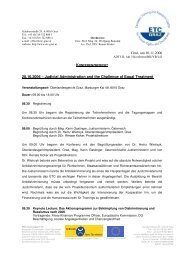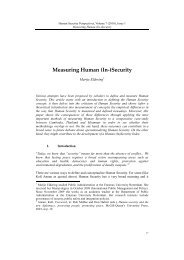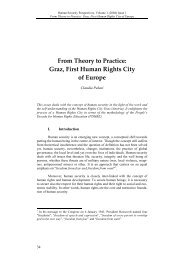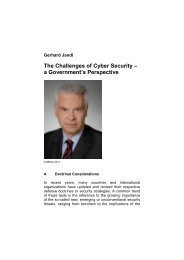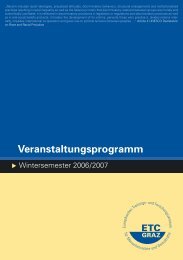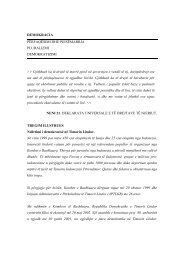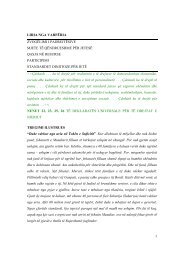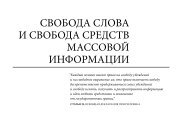Civil-military Coordination in the Common Security and ... - ETC Graz
Civil-military Coordination in the Common Security and ... - ETC Graz
Civil-military Coordination in the Common Security and ... - ETC Graz
You also want an ePaper? Increase the reach of your titles
YUMPU automatically turns print PDFs into web optimized ePapers that Google loves.
!<br />
A&<br />
!<br />
! BCAA&<br />
"#$%!&'$($)*!)+!!"#$%&<br />
'()"*+,-&.(*/0(),+1(/!<br />
#,%!-&&*!&'$(&'!-.!!<br />
&<br />
23456$%6&7(%(8(9&<br />
:$,,;+$/&(,,(#$%%&&<br />
!(+9(&:3%,$6&<br />
:$*9"/&:?/,4&&<br />
.$/)3$4&'$%,3/&.(*(+*$&<br />
!<br />
)*!-&#,/+!)+!(#&!012,*!<br />
3&415$(.!6)41%!75)18!,(!<br />
(#&!9*%($(1(&!)+!<br />
9*(&5*,($)*,/!:,;!,*'!<br />
9*(&5*,($)*,/!&5%$(.!)+!<br />
75,?@!A1%(5$,@!,*'!(#&!<br />
B15)8&,*!"5,$*$*C!,*'!<br />
Table of Contents<br />
Editors’ Preface .................................................................................. IV<br />
I Theory <strong>and</strong> Practice of Peace Build<strong>in</strong>g ...................................... 1<br />
Pascoal Santos Pereira<br />
Responsibility to Protect: One Step Towards A Liberal<br />
International Order? ............................................................................................. 2<br />
Andrej Zwitter<br />
Hybridization of Peacekeep<strong>in</strong>g: Emergence of New Doctr<strong>in</strong>es<br />
on Peace. ............................................................................................................. 14<br />
Markus Möstl<br />
<strong>Civil</strong>-<strong>military</strong> <strong>Coord<strong>in</strong>ation</strong> <strong>in</strong> <strong>the</strong> <strong>Common</strong> <strong>Security</strong> <strong>and</strong> Defence<br />
Policy of <strong>the</strong> European Union ............................................................................ 30<br />
Matthias C. Kettemann<br />
Lessons from Libya: A Test Case for Human <strong>Security</strong><br />
Ma<strong>in</strong>stream<strong>in</strong>g? .................................................................................................. 40<br />
Crist<strong>in</strong>a Churruca Muguruza/Crist<strong>in</strong>a de la Cruz Ayuso<br />
Human <strong>Security</strong> <strong>and</strong> Peacebuild<strong>in</strong>g: The Case of Internally<br />
Displaced People ................................................................................................ 53<br />
I
Table of Contents<br />
II Lessons from <strong>the</strong> Past ............................................................... 70<br />
II<br />
Sarah da Mota<br />
Human <strong>Security</strong> <strong>in</strong> Counter-Terrorist Policies dur<strong>in</strong>g <strong>the</strong> Bush<br />
Adm<strong>in</strong>istration (2001-2008) ................................................................................ 71<br />
Ulrike Capdepón<br />
The Influence of Human Rights Discourses <strong>and</strong> Practices from <strong>the</strong><br />
Sou<strong>the</strong>rn Cone on <strong>the</strong> Confrontation with <strong>the</strong> Franco Dictatorship<br />
<strong>in</strong> Spa<strong>in</strong> ................................................................................................................ 84<br />
III Post-Conflict Reconstruction .................................................... 91<br />
Thomas Rauter<br />
Trad<strong>in</strong>g Justice for Peace? Discretionary Possibilities for<br />
Renunciation of Crim<strong>in</strong>al Prosecution under <strong>the</strong> Rome Statute .................... 92<br />
Ramon Blanco<br />
Conflict Resolution <strong>in</strong> War-Torn Societies? Del<strong>in</strong>eat<strong>in</strong>g <strong>the</strong><br />
Post-Conflict State-Build<strong>in</strong>g Dispositif ........................................................... 103<br />
James-Emmanuel Wanki<br />
Whose DDR? (Re-) Exam<strong>in</strong><strong>in</strong>g <strong>the</strong> Questions of ‘Empowerment’<br />
<strong>and</strong> ‘Local Ownership’ <strong>in</strong> Disarmament, Demobilisation <strong>and</strong><br />
Re<strong>in</strong>tegration Endeavors <strong>in</strong> <strong>the</strong> Democratic Republic of Congo ................. 121<br />
Will Plowright<br />
Smooth<strong>in</strong>g <strong>the</strong> Contours of Violence: The Failure of DDR <strong>in</strong> Sierra<br />
Leone ................................................................................................................. 153
Table of Contents<br />
IV Challenges <strong>in</strong> Africa ................................................................ 164<br />
Valeria Izzi<br />
“No Nkunda No Job”: Rumours, Local Narratives <strong>and</strong><br />
Peacebuild<strong>in</strong>g <strong>in</strong> <strong>the</strong> Kivus, Democratic Republic of Congo ....................... 165<br />
Ojot Miru Ojulu<br />
The Role of <strong>Civil</strong> Society Organizations <strong>in</strong> Reconciliation <strong>and</strong><br />
Rebuild<strong>in</strong>g <strong>the</strong> Social Fabric of Communities Fractured by<br />
Protracted Conflicts: Case Study of Gambella Regional State<br />
of Ethiopia (2000-2006) ..................................................................................... 182<br />
Marcel Banza Mwengula<br />
<strong>Security</strong> Sector Reform <strong>and</strong> <strong>the</strong> Promotion of Human Rights <strong>and</strong><br />
International Humanitarian Law <strong>in</strong> Africa ....................................................... 195<br />
Workshop Programme .................................................................... 206<br />
Human <strong>Security</strong> Focus Group ........................................................ 211<br />
III
Markus MÖSTL*<br />
<strong>Civil</strong>-<strong>military</strong> <strong>Coord<strong>in</strong>ation</strong> <strong>in</strong> <strong>the</strong> <strong>Common</strong><br />
<strong>Security</strong> <strong>and</strong> Defence Policy of <strong>the</strong> European<br />
Union<br />
Abstract<br />
The concept of human security draws attention to <strong>the</strong> broadened scope of security<br />
threats <strong>and</strong> emphasizes <strong>the</strong> need for more comprehensive approaches to tackle<br />
<strong>the</strong>se threats. With <strong>the</strong> civilian <strong>and</strong> <strong>military</strong> tools available for its <strong>Common</strong> <strong>Security</strong><br />
<strong>and</strong> Defence Policy, <strong>the</strong> European Union is often considered to be <strong>in</strong> a particularly<br />
good position to offer <strong>the</strong> right mix of <strong>in</strong>struments required for comprehensive crisis<br />
management. But is <strong>the</strong> EU really able to live up to such expectations? What<br />
progress has <strong>the</strong> European Union made <strong>in</strong> coord<strong>in</strong>at<strong>in</strong>g its civilian <strong>and</strong> <strong>military</strong> tools<br />
for crisis management? By review<strong>in</strong>g <strong>the</strong> Union’s progress <strong>in</strong> def<strong>in</strong><strong>in</strong>g <strong>and</strong><br />
conceptualiz<strong>in</strong>g civil-<strong>military</strong> coord<strong>in</strong>ation, analys<strong>in</strong>g <strong>the</strong> developments made for <strong>the</strong><br />
<strong>in</strong>stitutionalization of civil-<strong>military</strong> coord<strong>in</strong>ation, discuss<strong>in</strong>g pert<strong>in</strong>ent questions related<br />
to capability development <strong>and</strong> review<strong>in</strong>g some practical experiences, this contribution<br />
gives an overview of <strong>the</strong> progress <strong>the</strong> European Union has made <strong>in</strong> civil-<strong>military</strong><br />
coord<strong>in</strong>ation. Overall, this paper will argue that <strong>the</strong> frequent conclusion that <strong>the</strong><br />
European Union is already able to provide <strong>in</strong>tegrated responses to today’s threats<br />
<strong>and</strong> crises is premature. Despite some real progress made <strong>in</strong> terms of concepts <strong>and</strong><br />
<strong>in</strong>stitutionalization, learn<strong>in</strong>g by do<strong>in</strong>g is still <strong>the</strong> name of <strong>the</strong> game <strong>in</strong> <strong>the</strong> operational<br />
practice.<br />
Table of Contents<br />
A! Introduction ....................................................................................................... 31!<br />
B! The CSDP Approach to <strong>Civil</strong>-<strong>military</strong> <strong>Coord<strong>in</strong>ation</strong> .......................................... 32!<br />
C! Institutions <strong>and</strong> Structures Relevant for CMCO ................................................ 34!<br />
D! The Implications of CMCO for <strong>Civil</strong>ian <strong>and</strong> Military Capabilities ....................... 35!<br />
E! Practical Examples of CMCO <strong>in</strong> <strong>the</strong> CSDP ...................................................... 36!<br />
F! Conclusions ...................................................................................................... 38!<br />
30
<strong>Civil</strong>-<strong>military</strong> <strong>Coord<strong>in</strong>ation</strong> <strong>in</strong> <strong>the</strong> <strong>Common</strong> <strong>Security</strong> <strong>and</strong> Defence Policy of <strong>the</strong> European Union<br />
A Introduction<br />
In <strong>the</strong> European <strong>Security</strong> Strategy 1 (ESS) <strong>and</strong> its Implementation Report, 2 <strong>the</strong><br />
member states (MS) of <strong>the</strong> European Union (EU) have publicly agreed that today’s<br />
security threats are not purely <strong>military</strong>. They also consented that today’s threats<br />
cannot be tackled by purely <strong>military</strong> means. 3 Ra<strong>the</strong>r, each response to a crisis or<br />
conflict, <strong>the</strong>y argue, requires a mixture of <strong>in</strong>struments. Experience has <strong>in</strong>deed shown<br />
that <strong>the</strong> traditional sequence of <strong>military</strong> <strong>in</strong>tervention followed by a civilian presence<br />
for reconstruction is not applicable anymore <strong>and</strong> that <strong>in</strong>tegrated concepts, which<br />
utilize all tools available already from <strong>the</strong> beg<strong>in</strong>n<strong>in</strong>g are needed. 4 Such <strong>in</strong>tegrated<br />
approaches are <strong>in</strong> l<strong>in</strong>e with contemporary security concepts, like human security,<br />
which draw attention to <strong>the</strong> broadened scope of security threats <strong>and</strong> emphasize <strong>the</strong><br />
need for more comprehensive approaches to tackle <strong>the</strong>se threats. 5<br />
The EU is often considered to be <strong>in</strong> a particularly good position to offer <strong>the</strong> right<br />
mix of <strong>in</strong>struments required for comprehensive crisis management. Javier Solana<br />
even believes that <strong>the</strong> comprehensive approach underp<strong>in</strong>n<strong>in</strong>g <strong>the</strong> <strong>Common</strong> <strong>Security</strong><br />
<strong>and</strong> Defence Policy (CSDP) is its value added. 6 Yet, what progress has <strong>the</strong> EU made<br />
thus far to coord<strong>in</strong>ate its civilian <strong>and</strong> <strong>military</strong> tools for crisis management? <strong>Civil</strong><strong>military</strong><br />
<strong>Coord<strong>in</strong>ation</strong> (CMCO) is usually regarded as a dem<strong>and</strong><strong>in</strong>g undertak<strong>in</strong>g that<br />
entails numerous steps <strong>and</strong> contentious issues. A successful implementation of<br />
CMCO would, for <strong>in</strong>stance, require a jo<strong>in</strong>t plann<strong>in</strong>g, a common doctr<strong>in</strong>e <strong>and</strong> jo<strong>in</strong>t<br />
tra<strong>in</strong><strong>in</strong>g, jo<strong>in</strong>t early warn<strong>in</strong>g, jo<strong>in</strong>t situation assessment <strong>and</strong> fact-f<strong>in</strong>d<strong>in</strong>g, coord<strong>in</strong>ated<br />
* Mag. iur. Markus Möstl is research fellow <strong>and</strong> doctoral student at <strong>the</strong> Institute of<br />
International Law <strong>and</strong> International Relations of <strong>the</strong> University of <strong>Graz</strong>, Austria. You may<br />
contact <strong>the</strong> author at: markus.moestl@uni-graz.at. The author would like to thank Sven<br />
Biscop for his valuable comments on an earlier draft of this paper which was presented at<br />
<strong>the</strong> 4th <strong>Graz</strong> Workshop on <strong>the</strong> Future of <strong>Security</strong>.<br />
1 Council of <strong>the</strong> European Union, A secure Europe <strong>in</strong> a better world – <strong>the</strong> European<br />
<strong>Security</strong> Strategy, approved by <strong>the</strong> European Council held <strong>in</strong> Brussels on 12 December<br />
2003 <strong>and</strong> drafted under <strong>the</strong> responsibilities of <strong>the</strong> EU High Representative Javier Solana.<br />
2 Council of <strong>the</strong> European Union, Report on <strong>the</strong> implementation of <strong>the</strong> European <strong>Security</strong><br />
Strategy – Provid<strong>in</strong>g security <strong>in</strong> a chang<strong>in</strong>g world, approved by <strong>the</strong> European Council<br />
held <strong>in</strong> Brussels on 11 <strong>and</strong> 12 December 2008 <strong>and</strong> drafted under <strong>the</strong> responsibilities of<br />
<strong>the</strong> EU High Representative Javier Solana.<br />
3 The threats were identified as <strong>the</strong> proliferation of weapons of mass destruction, regional<br />
conflicts, state failure, but also <strong>in</strong>clude terrorism, organized crime, <strong>and</strong> <strong>the</strong> effects of<br />
climate change.<br />
4 Margriet Drent/Dick Z<strong>and</strong>ee, Break<strong>in</strong>g pillars. Towards a civil-<strong>military</strong> security approach<br />
for <strong>the</strong> European Union, Ne<strong>the</strong>rl<strong>and</strong>s Institute of International Relations ‘Cl<strong>in</strong>gendael’,<br />
2010, 2.<br />
5 See, e.g., Commission on Human <strong>Security</strong>, Human <strong>Security</strong> Now, New York, 2003, 133;<br />
or Human <strong>Security</strong> Unit, Human <strong>Security</strong> <strong>in</strong> <strong>the</strong>ory <strong>and</strong> practice, Application of <strong>the</strong> Human<br />
<strong>Security</strong> Concept <strong>and</strong> <strong>the</strong> United Nations Trust Fund for Human <strong>Security</strong>, United Nations,<br />
Office for <strong>the</strong> <strong>Coord<strong>in</strong>ation</strong> of Humanitarian Affairs, 6.<br />
6 Javier Solana, Remarks at <strong>the</strong> conference ESDP@10: What lessons for <strong>the</strong> future,<br />
EUISS, Brussels, 28 July 2009.<br />
31
Markus MÖSTL<br />
comm<strong>and</strong> <strong>and</strong> control arrangements, <strong>and</strong> arrangements for <strong>the</strong> shar<strong>in</strong>g of<br />
<strong>in</strong>formation. 7<br />
This contribution <strong>in</strong>vestigates <strong>the</strong> EU’s progress <strong>in</strong> CMCO by first review<strong>in</strong>g <strong>the</strong><br />
EU def<strong>in</strong>ition <strong>and</strong> conceptualization of CMCO <strong>in</strong> Section B. Section C analyzes <strong>the</strong><br />
developments <strong>and</strong> achievements made for <strong>the</strong> <strong>in</strong>stitutionalization of CMCO before<br />
Section D discusses pert<strong>in</strong>ent questions related to <strong>the</strong> EU’s capability development<br />
process. Section E gives a brief overview of practical experiences of CMCO ga<strong>the</strong>red<br />
<strong>in</strong> Bosnia <strong>and</strong> Herzegov<strong>in</strong>a (BiH) <strong>and</strong> Section F will offer some overall conclusions<br />
expla<strong>in</strong><strong>in</strong>g why <strong>the</strong> EU still has to fur<strong>the</strong>r extend its coord<strong>in</strong>ation efforts for<br />
comprehensive crisis management operations.<br />
B The CSDP Approach to <strong>Civil</strong>-<strong>military</strong> <strong>Coord<strong>in</strong>ation</strong><br />
CMCO poses particularly high challenges for <strong>the</strong> EU. The <strong>in</strong>stitutional setup of <strong>the</strong><br />
EU implies that not only civilian <strong>and</strong> <strong>military</strong> aspects of <strong>the</strong> CSDP have to be<br />
coord<strong>in</strong>ated; it also means that <strong>the</strong> relevant activities of <strong>the</strong> European Commission,<br />
which usually address long-term needs, have to be coord<strong>in</strong>ated with <strong>the</strong> more shortterm<br />
measures taken by <strong>the</strong> Council of <strong>the</strong> EU under <strong>the</strong> CSDP. 8<br />
Indeed, <strong>the</strong> first conceptual work on CMCO took up <strong>the</strong> issue of <strong>in</strong>ter-<strong>in</strong>stitutional<br />
coord<strong>in</strong>ation <strong>in</strong> 2001, when <strong>the</strong> European Commission <strong>and</strong> <strong>the</strong> Council of <strong>the</strong> EU<br />
shared <strong>the</strong>ir relevant experiences <strong>and</strong> made proposals on how to <strong>in</strong>crease<br />
coord<strong>in</strong>ation <strong>and</strong> how to create synergies. 9 S<strong>in</strong>ce <strong>the</strong>n, a range of documents has<br />
been approved deal<strong>in</strong>g with CMCO on <strong>the</strong> strategic level with<strong>in</strong> <strong>the</strong> CSDP. Most<br />
prom<strong>in</strong>ently, <strong>the</strong> Council adopted an action plan <strong>in</strong>clud<strong>in</strong>g a checklist for <strong>the</strong><br />
improvement of CMCO. 10 This list comprises proposals to <strong>in</strong>clude coord<strong>in</strong>ation<br />
activities <strong>in</strong> <strong>the</strong> template for crisis management concepts, jo<strong>in</strong>t exercises <strong>and</strong> tra<strong>in</strong><strong>in</strong>g,<br />
<strong>and</strong> also suggestions for improvements of <strong>the</strong> coord<strong>in</strong>ation on an <strong>in</strong>stitutional level <strong>in</strong><br />
Brussels. A fur<strong>the</strong>r document detail<strong>in</strong>g <strong>the</strong> aims of CMCO claims that on <strong>the</strong> long run<br />
a “culture of coord<strong>in</strong>ation” should be developed for <strong>the</strong> civilian <strong>and</strong> <strong>military</strong> aspects of<br />
CSDP. 11<br />
Build<strong>in</strong>g on a non-paper by <strong>the</strong> United K<strong>in</strong>gdom, Austria <strong>and</strong> F<strong>in</strong>l<strong>and</strong>, which<br />
identifies key issue areas for <strong>the</strong> fur<strong>the</strong>r development of CMCO, 12 a framework paper<br />
7 Gustav Hägglund, EU's challenge to guarantee civil-<strong>military</strong> co-ord<strong>in</strong>ation <strong>in</strong> its future field<br />
operations, Hels<strong>in</strong>ki, 20 September 2002.<br />
8 This contribution, however, will ma<strong>in</strong>ly concentrate on CMCO <strong>in</strong> <strong>the</strong> CSDP.<br />
9 Council of <strong>the</strong> European Union, <strong>Civil</strong>-<strong>military</strong> co-ord<strong>in</strong>ation, Doc. 12307/02, Brussels, 24<br />
September 2002.<br />
10 Council of <strong>the</strong> European Union, Action plan for <strong>the</strong> fur<strong>the</strong>r streng<strong>the</strong>n<strong>in</strong>g of civil-<strong>military</strong><br />
co-ord<strong>in</strong>ation <strong>in</strong> EU crisis management, Doc. 13480/1/02 REV 1, Brussels, 29 October<br />
2002.<br />
11 Council of <strong>the</strong> European Union, <strong>Civil</strong> Military Co-ord<strong>in</strong>ation (CMCO), Doc. 14457/03,<br />
Brussels, 7 November 2003.<br />
12 Non-paper by <strong>the</strong> United K<strong>in</strong>gdom, Austria <strong>and</strong> F<strong>in</strong>l<strong>and</strong> for a sem<strong>in</strong>ar on CMCO, London,<br />
17 October 2005.<br />
32
<strong>Civil</strong>-<strong>military</strong> <strong>Coord<strong>in</strong>ation</strong> <strong>in</strong> <strong>the</strong> <strong>Common</strong> <strong>Security</strong> <strong>and</strong> Defence Policy of <strong>the</strong> European Union<br />
<strong>in</strong> 2006 for <strong>the</strong> first time made concrete proposals how to ensure coord<strong>in</strong>ation not<br />
only on <strong>the</strong> <strong>in</strong>stitutional level, but also <strong>in</strong> <strong>the</strong> field. 13 The paper underl<strong>in</strong>es <strong>the</strong> need<br />
for a clear strategy <strong>and</strong> precisely def<strong>in</strong>ed goals for all EU actors on <strong>the</strong> ground <strong>and</strong><br />
emphasizes <strong>the</strong> need for a common underst<strong>and</strong><strong>in</strong>g of <strong>the</strong> overall aims of <strong>the</strong> EU’s<br />
engagement. Moreover, that paper makes suggestions for <strong>the</strong> improvement of<br />
logistics, <strong>and</strong> addresses issues related to <strong>the</strong> co-location of headquarters <strong>and</strong> <strong>the</strong><br />
central role of <strong>the</strong> EU Special Representatives (EUSR) for CMCO <strong>in</strong> <strong>the</strong> field.<br />
The latest conceptual paper on CMCO outl<strong>in</strong>es possible solutions for <strong>in</strong>formation<br />
shar<strong>in</strong>g <strong>and</strong> stresses that on <strong>the</strong> long run a situation should be achieved <strong>in</strong> which EU<br />
crisis management is regarded as a jo<strong>in</strong>t effort by civilian <strong>and</strong> <strong>military</strong> means, which<br />
should be able to share <strong>in</strong>formation through established <strong>in</strong>formation networks. 14<br />
At this po<strong>in</strong>t, it should also be briefly mentioned that efforts for <strong>Civil</strong>-<strong>military</strong><br />
Cooperation (CIMIC) are also embedded <strong>in</strong>to <strong>the</strong> EU’s concept for CMCO. However,<br />
<strong>the</strong>re is a fundamental difference between CMCO <strong>and</strong> CIMIC. CIMIC is about <strong>the</strong><br />
coord<strong>in</strong>ation <strong>and</strong> cooperation at all levels – “between <strong>military</strong> components of EU-led<br />
<strong>military</strong> operations <strong>and</strong> civil actors external to <strong>the</strong> EU, <strong>in</strong>clud<strong>in</strong>g <strong>the</strong> local population<br />
<strong>and</strong> authorities, as well as <strong>in</strong>ternational, national <strong>and</strong> nongovernmental organisations<br />
<strong>and</strong> agencies - <strong>in</strong> support of <strong>the</strong> achievement of <strong>the</strong> <strong>military</strong> mission along with all<br />
o<strong>the</strong>r <strong>military</strong> functions.” 15 It should suffice here to briefly po<strong>in</strong>t out that <strong>in</strong> 2008 <strong>the</strong><br />
Council of <strong>the</strong> EU adopted a revised CIMIC concept establish<strong>in</strong>g <strong>the</strong> basis <strong>and</strong><br />
framework for <strong>the</strong> plann<strong>in</strong>g <strong>and</strong> execution of all CIMIC activities <strong>and</strong> outl<strong>in</strong><strong>in</strong>g <strong>the</strong><br />
guid<strong>in</strong>g pr<strong>in</strong>ciples for CIMIC. Accord<strong>in</strong>g to that document, <strong>the</strong> ma<strong>in</strong> CIMIC functions<br />
are civil-<strong>military</strong> liaison, support to <strong>the</strong> civilian environment <strong>and</strong> support to <strong>the</strong> <strong>military</strong><br />
force. 16<br />
Thus, on a conceptual level <strong>the</strong> EU developed a detailed underst<strong>and</strong><strong>in</strong>g of how<br />
civilian <strong>and</strong> <strong>military</strong> tools of <strong>the</strong> CSDP should be coord<strong>in</strong>ated. The progress made <strong>in</strong><br />
<strong>the</strong> development of <strong>the</strong> CMCO concept also had an <strong>in</strong>fluence on o<strong>the</strong>r EU concepts<br />
for crisis management. Most importantly, <strong>the</strong> relevance of CMCO was acknowledged<br />
13 Council of <strong>the</strong> European Union, <strong>Civil</strong>-Military Co-ord<strong>in</strong>ation: Framework paper of possible<br />
solutions for <strong>the</strong> management of EU Crisis Management Operations, Doc. 8926/06,<br />
Brussels, 2 May 2006.<br />
14 Council of <strong>the</strong> European Union, <strong>Civil</strong>-Military Co-ord<strong>in</strong>ation (CMCO): Possible solutions<br />
for <strong>the</strong> management of EU Crisis Management Operations - Improv<strong>in</strong>g <strong>in</strong>formation<br />
shar<strong>in</strong>g <strong>in</strong> support of EU crisis management operations, Doc. 13218/5/06 REV 5,<br />
Brussels, 31 October 2006.<br />
15 Council of <strong>the</strong> European Union, EU Concept for <strong>Civil</strong>-Military Co-operation (CIMIC) for<br />
EU-led Military Operations, Doc. 11716/08 REV 1, Brussels, 3 February 2009, para. 15,<br />
(emphasis added by <strong>the</strong> author).<br />
16 Council of <strong>the</strong> European Union, <strong>Civil</strong>-<strong>military</strong> co-operation (CIMIC) concept for EU-led<br />
crisis management operations, Doc. 11716/08 REV 1, para. 16. An earlier version is also<br />
available: Council of <strong>the</strong> European Union, <strong>Civil</strong>-<strong>military</strong> co-operation (CIMIC) concept for<br />
EU-led crisis management operations, Doc. 7106/02, Brussels, 18 March 2002. Through<br />
CIMIC reconstruction activities, adm<strong>in</strong>istrative support <strong>and</strong> humanitarian aid performed by<br />
<strong>the</strong> <strong>military</strong> should help to stabilize <strong>the</strong> country or region through <strong>the</strong>ir effects on <strong>the</strong><br />
economic, social <strong>and</strong> political sector.<br />
33
Markus MÖSTL<br />
<strong>in</strong> <strong>the</strong> EU <strong>military</strong> comm<strong>and</strong> <strong>and</strong> control concept. 17 While at <strong>the</strong> beg<strong>in</strong>n<strong>in</strong>g of CMCO<br />
<strong>in</strong> 2001 <strong>the</strong> coord<strong>in</strong>ation between <strong>the</strong> Council of <strong>the</strong> EU <strong>and</strong> <strong>the</strong> Commission was <strong>in</strong><br />
<strong>the</strong> focus of coord<strong>in</strong>ation efforts, concepts for CMCO now concentrate on <strong>the</strong><br />
coord<strong>in</strong>ation with<strong>in</strong> <strong>the</strong> CSDP. Overall, it can be seen from <strong>the</strong> concept papers that<br />
MS acknowledge that <strong>the</strong> overall effectiveness of EU crisis management operations<br />
can be enhanced with CMCO. 18<br />
C Institutions <strong>and</strong> Structures Relevant for CMCO<br />
An effective coord<strong>in</strong>ation of civil <strong>and</strong> <strong>military</strong> tools for crisis management also<br />
requires strategic coord<strong>in</strong>ation among <strong>the</strong> <strong>in</strong>stitutions <strong>and</strong> structures <strong>in</strong>volved. The<br />
CSDP structures were established ra<strong>the</strong>r quickly <strong>and</strong> <strong>in</strong> <strong>in</strong>stitutional terms, <strong>the</strong><br />
developments <strong>in</strong> <strong>the</strong> <strong>military</strong> doma<strong>in</strong> were always one step ahead of <strong>the</strong> civilian<br />
doma<strong>in</strong>. 19 When <strong>the</strong> EU <strong>military</strong> staff (EUMS), tasked with early warn<strong>in</strong>g, strategic<br />
plann<strong>in</strong>g <strong>and</strong> situation assessment for <strong>military</strong> operations, was established <strong>in</strong> 2001,<br />
<strong>the</strong>re was no equivalent civilian <strong>in</strong>stitution with which coord<strong>in</strong>ation would have been<br />
possible.<br />
The first step to <strong>in</strong>stitutionalize CMCO was <strong>the</strong> establishment of <strong>the</strong> <strong>Civil</strong>-Military<br />
Cell <strong>in</strong> 2004, 20 which was set up with<strong>in</strong> <strong>the</strong> EUMS. In terms of CMCO, <strong>the</strong> ma<strong>in</strong><br />
achievement of this cell was its “Strategic Plann<strong>in</strong>g Branch", which was composed of<br />
<strong>military</strong> <strong>and</strong> civilian planners, <strong>in</strong>clud<strong>in</strong>g officers from <strong>the</strong> Commission. In this way, a<br />
permanent l<strong>in</strong>k to <strong>the</strong> Commission was established with<strong>in</strong> <strong>the</strong> General Secretariat of<br />
<strong>the</strong> Council. Although <strong>the</strong> <strong>Civil</strong>-Military Cell was certa<strong>in</strong>ly supportive to <strong>the</strong> technical<br />
side of civilian operations, for <strong>in</strong>stance with regard to logistics or medical evacuation,<br />
it was, however, not sufficiently equipped to perform a detailed plann<strong>in</strong>g for civilian<br />
missions. The plann<strong>in</strong>g of police missions or rule of law missions still rested upon <strong>the</strong><br />
Head of Mission. The establishment of <strong>the</strong> <strong>Civil</strong>-Military Cell with<strong>in</strong> <strong>the</strong> EUMS also<br />
gave rise to doubts about <strong>the</strong> truly civil-<strong>military</strong> character of this cell. It may thus be<br />
concluded that <strong>the</strong> <strong>Civil</strong>-Military Cell was certa<strong>in</strong>ly an important step, but on <strong>the</strong> long<br />
run it turned out to be <strong>in</strong>sufficient for effective CMCO.<br />
It took seven years until a civilian equivalent to <strong>the</strong> EUMS was established with<br />
<strong>the</strong> so-called <strong>Civil</strong>ian Plann<strong>in</strong>g <strong>and</strong> Conduct Capability (CPCC). The CPCC has <strong>the</strong><br />
m<strong>and</strong>ate to plan <strong>and</strong> comm<strong>and</strong> civilian missions at <strong>the</strong> strategic level. Thus, s<strong>in</strong>ce<br />
2008 <strong>the</strong> civilian <strong>and</strong> <strong>military</strong> structures became at least comparable to <strong>the</strong> <strong>military</strong><br />
structures. Yet, hav<strong>in</strong>g both civilian <strong>and</strong> <strong>military</strong> structures does not necessarily mean<br />
17 Council of <strong>the</strong> European Union, EU Military C2 Concept, Doc. 11096/03 EXT 1, Brussels,<br />
26 July 2006, 20.<br />
18 See also Radek Kohl, <strong>Civil</strong>-<strong>military</strong> co-ord<strong>in</strong>ation <strong>in</strong> EU crisis management, <strong>in</strong>: Nowak,<br />
Agnieszka (ed.), <strong>Civil</strong>ian crisis management: <strong>the</strong> EU way, European Union Institute for<br />
<strong>Security</strong> Studies, Paris, 2006, 123.<br />
19 Margriet Drent/Dick Z<strong>and</strong>ee, Break<strong>in</strong>g pillars, 2010, 25 <strong>and</strong> 28.<br />
20 Council of <strong>the</strong> European Union, <strong>Civil</strong> Military Cell - Terms of Reference, Doc. 10580/1/04<br />
REV 1, Brussels, 8 September 2005.<br />
34
<strong>Civil</strong>-<strong>military</strong> <strong>Coord<strong>in</strong>ation</strong> <strong>in</strong> <strong>the</strong> <strong>Common</strong> <strong>Security</strong> <strong>and</strong> Defence Policy of <strong>the</strong> European Union<br />
that <strong>the</strong>se structures coord<strong>in</strong>ate <strong>the</strong>ir activities for <strong>the</strong> plann<strong>in</strong>g <strong>and</strong> conduct of CSDP<br />
missions <strong>and</strong> operations.<br />
The most important decision to fur<strong>the</strong>r CMCO on <strong>the</strong> <strong>in</strong>stitutional level taken so<br />
far was made <strong>in</strong> 2009. The civilian <strong>and</strong> defence directorates, formerly separate<br />
entities <strong>in</strong> <strong>the</strong> Council Secretariat, were merged with parts of <strong>the</strong> <strong>Civil</strong>-Military Cell to<br />
form a new Crisis Management <strong>and</strong> Plann<strong>in</strong>g Directorate (CMPD). It is essential to<br />
note that <strong>the</strong> CMPD may work closely with <strong>the</strong> CPCC <strong>and</strong> <strong>the</strong> <strong>military</strong> EU Operations<br />
Centre as well as o<strong>the</strong>r <strong>military</strong> <strong>and</strong> civilian structures of <strong>the</strong> EU. Therefore, this<br />
directorate today is a structure composed of civilian <strong>and</strong> <strong>military</strong> personnel tasked<br />
with <strong>the</strong> strategic plann<strong>in</strong>g of CSDP operations <strong>and</strong> truly bridg<strong>in</strong>g civilian <strong>and</strong> <strong>military</strong><br />
structures. It may, however, be questioned to what extent this <strong>in</strong>stitutional<br />
coord<strong>in</strong>ation has an impact on <strong>the</strong> field level, where so far no common civil-<strong>military</strong><br />
structures exist.<br />
D The Implications of CMCO for <strong>Civil</strong>ian <strong>and</strong> Military<br />
Capabilities<br />
CMCO is a complex process that also has implications for <strong>the</strong> development <strong>and</strong><br />
tra<strong>in</strong><strong>in</strong>g of civilian <strong>and</strong> <strong>military</strong> capabilities. S<strong>in</strong>ce <strong>the</strong> EU has no own assets to<br />
deploy, <strong>the</strong> MS make some of <strong>the</strong>ir civilian <strong>and</strong> <strong>military</strong> capabilities available for EU<br />
crisis management operations. In so-called headl<strong>in</strong>e goals, <strong>the</strong> MS have agreed on<br />
<strong>the</strong> numbers of civil <strong>and</strong> <strong>military</strong> capabilities <strong>the</strong>y are ready to contribute to EU<br />
operations <strong>and</strong> missions.<br />
For our analysis of CMCO, <strong>in</strong> <strong>the</strong> CSDP it is of particular importance that <strong>the</strong><br />
process of capability-development was made on two separate tracks so far – a<br />
civilian 21 <strong>and</strong> a <strong>military</strong> 22 one. Both headl<strong>in</strong>e goals were to be reached by 2010 <strong>and</strong><br />
reviews of <strong>the</strong> member states’ contributions show that <strong>the</strong>re are still gaps <strong>in</strong><br />
qualitative <strong>and</strong> quantitative terms. While <strong>the</strong>re are some first plans on how <strong>the</strong><br />
capability development process shall cont<strong>in</strong>ue <strong>in</strong> <strong>the</strong> future, 23 some argue that<br />
<strong>in</strong>stead of two separate headl<strong>in</strong>e goals, <strong>in</strong>tegrated scenarios <strong>and</strong> <strong>the</strong> experience from<br />
civil-<strong>military</strong> operations should guide <strong>the</strong> fur<strong>the</strong>r development of a jo<strong>in</strong>t civil-<strong>military</strong><br />
headl<strong>in</strong>e goal, because this would better reflect <strong>the</strong> capabilities needed on <strong>the</strong><br />
ground. 24<br />
21 <strong>Civil</strong>ian Headl<strong>in</strong>e Goal 2010, approved by <strong>the</strong> m<strong>in</strong>isterial <strong>Civil</strong>ian Capabilities<br />
Improvement Conference <strong>and</strong> noted by <strong>the</strong> General Affairs <strong>and</strong> External Relations<br />
Council on 19 November 2007.<br />
22 Headl<strong>in</strong>e Goal 2010, approved by General Affairs <strong>and</strong> External Relations Council on 17<br />
May 2004 endorsed by <strong>the</strong> European Council of 17 <strong>and</strong> 18 June 2004.<br />
23 Council of <strong>the</strong> European Union, EU civilian <strong>and</strong> <strong>military</strong> capability development beyond<br />
2010, Doc. 17127/10, Brussels, 7 December 2010.<br />
24 Claudia Major/Christian Möll<strong>in</strong>g, EU <strong>military</strong> capabilities. Some European troops, but not<br />
yet an army. In Ettore Greco; Pirozzi, Nicoletta <strong>and</strong> Silvestri, Stefano (eds.): EU crisis<br />
management. Institutions <strong>and</strong> capabilities <strong>in</strong> <strong>the</strong> mak<strong>in</strong>g, Rome, 2010, 23.<br />
35
Markus MÖSTL<br />
CMCO also concerns <strong>the</strong> proper tra<strong>in</strong><strong>in</strong>g of civil <strong>and</strong> <strong>military</strong> capabilities. Some<br />
tra<strong>in</strong><strong>in</strong>g concepts of MS already address <strong>the</strong> issue of jo<strong>in</strong>t civil-<strong>military</strong> tra<strong>in</strong><strong>in</strong>g. The<br />
Swedish Folke Bernadotte Academy, for <strong>in</strong>stance, identified manifold <strong>in</strong>terfaces<br />
relevant for civil-<strong>military</strong> tra<strong>in</strong><strong>in</strong>g. These <strong>in</strong>clude public order, organized crime, border<br />
control, disarmament, demobilization <strong>and</strong> re<strong>in</strong>tegration, civil protection, elections,<br />
<strong>in</strong>telligence, security provision for humanitarian actors, transport <strong>and</strong><br />
telecommunications. Fur<strong>the</strong>r areas would <strong>in</strong>clude human traffick<strong>in</strong>g, witness<br />
protection or security sector reform. 25<br />
Although <strong>the</strong> EU tra<strong>in</strong><strong>in</strong>g concept for CSDP only briefly mentions CMCO, 26 <strong>the</strong>re<br />
seems to be a wide overall agreement that jo<strong>in</strong>t tra<strong>in</strong><strong>in</strong>gs are one of <strong>the</strong> most<br />
important means to develop a common underst<strong>and</strong><strong>in</strong>g for civil-<strong>military</strong> operations <strong>and</strong><br />
may be a prime means to establish <strong>the</strong> aspired “culture of coord<strong>in</strong>ation”. Yet, <strong>the</strong><br />
responsibility for <strong>the</strong> tra<strong>in</strong><strong>in</strong>g of staff still rests with <strong>the</strong> MS, <strong>and</strong> <strong>in</strong> practice <strong>the</strong>re is no<br />
obligation for <strong>the</strong> MS to conduct jo<strong>in</strong>t tra<strong>in</strong><strong>in</strong>gs for civilian <strong>and</strong> <strong>military</strong> staff.<br />
Fur<strong>the</strong>r improvements for CMCO <strong>in</strong> terms of capabilities are still <strong>in</strong> progress. In<br />
December 2010, <strong>the</strong> European Council emphasized <strong>the</strong> potential of civil-<strong>military</strong><br />
synergies <strong>in</strong> capability development <strong>and</strong> particularly highlighted <strong>the</strong> added value of<br />
dual use capabilities <strong>in</strong> this regard. 27 Currently, more concrete actions are be<strong>in</strong>g<br />
identified on European level that should br<strong>in</strong>g more tangible results <strong>in</strong> this area. 28<br />
E Practical Examples of CMCO <strong>in</strong> <strong>the</strong> CSDP<br />
While a lot of attention has been paid to <strong>the</strong> <strong>military</strong> branch of <strong>the</strong> CSDP dur<strong>in</strong>g its<br />
first years, it would be <strong>in</strong>accurate to regard its <strong>military</strong> branch as <strong>the</strong> most important<br />
aspect of EU crisis management <strong>in</strong> practice. 29 In fact, most of <strong>the</strong> CSDP missions<br />
were civilian <strong>in</strong> nature, or had a significant civilian component. Look<strong>in</strong>g at <strong>the</strong><br />
operational practice of <strong>the</strong> CSDP reveals that <strong>the</strong> EU conducts numerous civil<strong>military</strong><br />
operations or has civilian <strong>and</strong> <strong>military</strong> operations ongo<strong>in</strong>g <strong>in</strong> a s<strong>in</strong>gle <strong>the</strong>atre<br />
of operation. 30 The question rema<strong>in</strong>s, however, to what extent <strong>the</strong>se engagements<br />
are successful <strong>in</strong> terms of coord<strong>in</strong>ation.<br />
25 Renata Dwan, <strong>Civil</strong>ian tasks <strong>and</strong> capabilities <strong>in</strong> EU operations. In: Marlies Glasius/Marlies<br />
<strong>and</strong> Mary Kaldor (eds.), A Human <strong>Security</strong> doctr<strong>in</strong>e for Europe. Project, pr<strong>in</strong>ciples,<br />
practicalities, New York, Routledge, 2006, 279.<br />
26 Council of <strong>the</strong> European Union, Draft EU Tra<strong>in</strong><strong>in</strong>g Concept <strong>in</strong> ESDP, Doc. 11970/04,<br />
Brussels, 30 August 2004, 9.<br />
27 Council of <strong>the</strong> European Union, Council conclusions on <strong>military</strong> capability development,<br />
3055th Foreign Affairs (Defence) Council meet<strong>in</strong>g, Brussels, 9 December 2010, para. 9.<br />
28 Council of <strong>the</strong> European Union, Promot<strong>in</strong>g Synergies between <strong>the</strong> EU <strong>Civil</strong> <strong>and</strong> Military<br />
Capability Development – Way ahead, Doc. 17285/10, Brussels, 6 December 2010.<br />
29 Jolyon Howorth, <strong>Security</strong> <strong>and</strong> defence policy <strong>in</strong> <strong>the</strong> European Union. New York, Palgrave<br />
Macmillan, 2007, 93.<br />
30 For an overview of <strong>the</strong> CSDP missions <strong>and</strong> operations see <strong>the</strong> CSDP website at<br />
http://consilium.europa.eu/showPage.aspx?id=268&lang=en. Prime examples are <strong>the</strong><br />
36
<strong>Civil</strong>-<strong>military</strong> <strong>Coord<strong>in</strong>ation</strong> <strong>in</strong> <strong>the</strong> <strong>Common</strong> <strong>Security</strong> <strong>and</strong> Defence Policy of <strong>the</strong> European Union<br />
The most important test<strong>in</strong>g ground for CMCO was BiH, where <strong>the</strong> EU for <strong>the</strong> first<br />
time conducted a <strong>military</strong> operation <strong>and</strong> civilian mission <strong>in</strong> <strong>the</strong> same country: <strong>the</strong><br />
police mission EUPM (start<strong>in</strong>g <strong>in</strong> 2003) <strong>and</strong> <strong>the</strong> <strong>military</strong> operation EUFOR Al<strong>the</strong>a<br />
(start<strong>in</strong>g at <strong>the</strong> end of 2005). In this case, CMCO proved to be difficult due to<br />
different, but overlapp<strong>in</strong>g m<strong>and</strong>ates. EUFOR had an executive m<strong>and</strong>ate, while EUPM<br />
was monitor<strong>in</strong>g <strong>and</strong> mentor<strong>in</strong>g <strong>the</strong> local law enforcement agencies, but both were<br />
simultaneously engaged <strong>in</strong> <strong>the</strong> fight aga<strong>in</strong>st organized crime. The manner <strong>in</strong> which<br />
EUFOR implemented its m<strong>and</strong>ate caused critique on <strong>the</strong> side of EUPM. EUFOR<br />
carried out its executive m<strong>and</strong>ate very actively, which somehow h<strong>in</strong>dered <strong>the</strong><br />
implementation of a basic idea <strong>in</strong>herent <strong>in</strong> EUPM, namely that <strong>the</strong> local authorities<br />
should have <strong>the</strong> prime responsibility. 31<br />
It was also reported that a lack of coord<strong>in</strong>ation led to situations, <strong>in</strong> which <strong>the</strong> EU<br />
police mission received <strong>in</strong>formation about EU <strong>military</strong> operations from <strong>the</strong> local<br />
police, not from EUFOR itself. 32 Fur<strong>the</strong>rmore, <strong>the</strong> <strong>in</strong>tegrated police units of EUFOR<br />
were criticized by EUPM for carry<strong>in</strong>g out operations without <strong>in</strong>form<strong>in</strong>g EUPM or <strong>the</strong><br />
local authorities. 33<br />
Thus, <strong>the</strong> first year of coexistence of two EU missions <strong>in</strong> BiH was characterized<br />
by contrar<strong>in</strong>ess <strong>in</strong> <strong>the</strong> m<strong>and</strong>ates <strong>and</strong> <strong>the</strong> executions of <strong>the</strong> missions. However, with<br />
<strong>the</strong> adoption of pr<strong>in</strong>ciples <strong>and</strong> guidel<strong>in</strong>es for cooperation between EUPM, EUFOR<br />
<strong>and</strong> <strong>the</strong> EUSR real progress has been achieved. Especially <strong>the</strong> EUSR’s role <strong>in</strong><br />
mediation <strong>in</strong>creased <strong>and</strong> regular meet<strong>in</strong>gs at different levels were established,<br />
<strong>in</strong>dicat<strong>in</strong>g <strong>the</strong> evolution <strong>and</strong> progress of CMCO <strong>in</strong> BiH. 34 Overall, it seems that <strong>the</strong><br />
ma<strong>in</strong> problem with regard to CMCO <strong>in</strong> BiH was that <strong>the</strong>re was no comprehensive<br />
plann<strong>in</strong>g right from <strong>the</strong> beg<strong>in</strong>n<strong>in</strong>g. With today’s concepts <strong>and</strong> <strong>the</strong> CMPD at h<strong>and</strong>, it<br />
may well be assumed that <strong>in</strong>tegrated plann<strong>in</strong>g would play a more substantial role<br />
from <strong>the</strong> beg<strong>in</strong>n<strong>in</strong>g.<br />
Although BiH <strong>and</strong> fur<strong>the</strong>r case studies 35 show that progress has been made <strong>in</strong> <strong>the</strong><br />
field, it is difficult to evaluate to which extent <strong>the</strong> EU has learned <strong>the</strong> lessons on<br />
CMCO. This is also due to <strong>the</strong> fact that pert<strong>in</strong>ent reports by <strong>the</strong> EU are not available<br />
to <strong>the</strong> public. 36<br />
civil missions <strong>and</strong> <strong>military</strong> operations <strong>in</strong> <strong>the</strong> Democratic Republic of Congo, <strong>the</strong> Former<br />
Yugoslavian Republic of Macedonia, <strong>and</strong> Bosnia <strong>and</strong> Herzegov<strong>in</strong>a.<br />
31 Jari Mustoneni, <strong>Coord<strong>in</strong>ation</strong> <strong>and</strong> cooperation on tactical <strong>and</strong> operational level: Study<strong>in</strong>g<br />
EU-ESDP crisis management <strong>in</strong>struments <strong>in</strong> Bosnia <strong>and</strong> Herzegov<strong>in</strong>a, Crisis<br />
Management Centre F<strong>in</strong>l<strong>and</strong>, 2008, 22.<br />
32 Jari Mustonen, <strong>Coord<strong>in</strong>ation</strong> <strong>and</strong> cooperation on tactical <strong>and</strong> operational level, 22.<br />
33 Jari Mustonen, <strong>Coord<strong>in</strong>ation</strong> <strong>and</strong> cooperation on tactical <strong>and</strong> operational level, 22.<br />
34 Jari Mustonen, <strong>Coord<strong>in</strong>ation</strong> <strong>and</strong> cooperation on tactical <strong>and</strong> operational level, 28.<br />
35 CMCO was reported to be successful dur<strong>in</strong>g EUFOR RD Congo at large. In this case, <strong>the</strong><br />
EUSR for <strong>the</strong> Great Lakes Region aga<strong>in</strong> played a key role <strong>and</strong> weekly meet<strong>in</strong>gs of<br />
representatives of EUFOR RD Congo, EUPOL <strong>and</strong> EUSEC proved to be highly valuable.<br />
Cf. Hans-Georg Ehrhart, <strong>Civil</strong>-<strong>military</strong> co-operation <strong>and</strong> co-ord<strong>in</strong>ation <strong>in</strong> <strong>the</strong> EU <strong>and</strong> <strong>in</strong><br />
selected member states, Study for <strong>the</strong> European Parliament, 2007, 18 et seqq.<br />
36 In 2008, <strong>the</strong> Council of <strong>the</strong> European Union adopted Doc. 9885/07 EXT 1 on “<strong>Civil</strong><strong>military</strong><br />
<strong>Coord<strong>in</strong>ation</strong> <strong>in</strong> <strong>the</strong> EU Support<strong>in</strong>g action to <strong>the</strong> AU <strong>in</strong> Darfur - Case Study <strong>and</strong><br />
37
Markus MÖSTL<br />
F Conclusions<br />
Concepts like human security have changed our underst<strong>and</strong><strong>in</strong>g of how to best tackle<br />
today’s threats <strong>and</strong> crises. The grow<strong>in</strong>g dem<strong>and</strong> for civil-<strong>military</strong> missions <strong>and</strong> <strong>the</strong><br />
qualitative requirements for CMCO pose a real challenge for <strong>the</strong> EU.<br />
On a conceptual level, it seems that CMCO is taken very seriously with<strong>in</strong> <strong>the</strong> EU<br />
<strong>and</strong> <strong>the</strong> potential value added by CMCO seems to be undisputed. It appears that it<br />
became a common underst<strong>and</strong><strong>in</strong>g of <strong>the</strong> MS that CMCO should be on <strong>the</strong> agenda<br />
not only for <strong>the</strong> plann<strong>in</strong>g <strong>and</strong> conduct of a concrete operation, but also dur<strong>in</strong>g <strong>the</strong><br />
rout<strong>in</strong>e phase.<br />
In <strong>in</strong>stitutional terms, some serious problems still rema<strong>in</strong>. The Lisbon Treaty<br />
dim<strong>in</strong>ished <strong>the</strong> pillar structure of <strong>the</strong> EU, but did not alter <strong>the</strong> still separate<br />
responsibilities of <strong>the</strong> Commission <strong>and</strong> <strong>the</strong> Council of <strong>the</strong> EU. Due to <strong>the</strong> different<br />
competences of <strong>the</strong>se <strong>in</strong>stitutions, none of <strong>the</strong> actors may oblige <strong>the</strong> o<strong>the</strong>r to<br />
coord<strong>in</strong>ate or to be coord<strong>in</strong>ated. All documents adopted <strong>in</strong> this regard are <strong>the</strong>refore<br />
only recommendations <strong>and</strong> <strong>in</strong> no way b<strong>in</strong>d<strong>in</strong>g. Although it seems that all actors<br />
<strong>in</strong>volved basically agree on <strong>the</strong> importance of CMCO, <strong>the</strong> question rema<strong>in</strong>s where<br />
<strong>the</strong> limitations for coord<strong>in</strong>ation lie <strong>in</strong> practice. 37 The read<strong>in</strong>ess <strong>and</strong> ability to<br />
coord<strong>in</strong>ate may vary from one <strong>in</strong>stance to ano<strong>the</strong>r, <strong>and</strong> might <strong>the</strong>refore h<strong>in</strong>der<br />
permanent <strong>and</strong> systematic solutions pay<strong>in</strong>g due attention to CMCO.<br />
The coord<strong>in</strong>ation between <strong>the</strong> civil <strong>and</strong> <strong>military</strong> <strong>in</strong>stitutions of <strong>the</strong> CSDP, however,<br />
seems to be less problematic. 38 It is noteworthy that <strong>the</strong> <strong>in</strong>stitutional framework for<br />
<strong>military</strong> crisis management was developed more vigorously from <strong>the</strong> beg<strong>in</strong>n<strong>in</strong>g. It<br />
may well be argued that <strong>the</strong> civilian dimension came <strong>in</strong> later <strong>and</strong> for a long time was<br />
not able to alter <strong>the</strong> basic approaches for crisis management, e.g., for <strong>the</strong> plann<strong>in</strong>g of<br />
operations. With <strong>the</strong> establishment of <strong>the</strong> CMPD real progress was made, as this<br />
body encompasses civil <strong>and</strong> <strong>military</strong> experts that have established contacts with <strong>the</strong><br />
ma<strong>in</strong> civilian <strong>and</strong> <strong>military</strong> structures of <strong>the</strong> EU. The CMPD will <strong>the</strong>refore also have a<br />
key role <strong>in</strong> fur<strong>the</strong>r advanc<strong>in</strong>g CMCO. 39<br />
Look<strong>in</strong>g at <strong>the</strong> mere numbers of civilian <strong>and</strong> <strong>military</strong> capabilities <strong>the</strong> MS<br />
committed <strong>the</strong>mselves to provide for EU operations <strong>and</strong> missions, one is tempted to<br />
conclude that <strong>the</strong> EU <strong>in</strong>deed has <strong>the</strong> ability to deploy <strong>in</strong>tegrated packages of civil <strong>and</strong><br />
<strong>military</strong> <strong>in</strong>struments. Yet, when tak<strong>in</strong>g a closer look at <strong>the</strong> capability development<br />
process, <strong>the</strong> picture is not that encourag<strong>in</strong>g anymore. In practice, not all of <strong>the</strong><br />
personnel committed by <strong>the</strong> MS will be made available to <strong>the</strong> EU <strong>and</strong> <strong>the</strong>re is no<br />
guarantee that <strong>the</strong> personnel will be tra<strong>in</strong>ed <strong>in</strong> CMCO to any extent. How should <strong>the</strong>y<br />
live <strong>and</strong> implement a “culture of coord<strong>in</strong>ation”?<br />
Recommendations”. The part <strong>in</strong>clud<strong>in</strong>g <strong>the</strong> case study <strong>and</strong> <strong>the</strong> result<strong>in</strong>g recommendation<br />
has, however, not been declassified.<br />
37 Hans-Georg Ehrhart, <strong>Civil</strong>-<strong>military</strong> co-operation <strong>and</strong> co-ord<strong>in</strong>ation <strong>in</strong> <strong>the</strong> EU <strong>and</strong> <strong>in</strong><br />
selected member states, 10 et seq.<br />
38 See Radek Kohl, <strong>Civil</strong>ian crisis management: <strong>the</strong> EU way, 127.<br />
39 Despite this progress, some argue that only a jo<strong>in</strong>t civil-<strong>military</strong> headquarter would reflect<br />
a truly successful <strong>in</strong>stitutionalization of CMCO.<br />
38
<strong>Civil</strong>-<strong>military</strong> <strong>Coord<strong>in</strong>ation</strong> <strong>in</strong> <strong>the</strong> <strong>Common</strong> <strong>Security</strong> <strong>and</strong> Defence Policy of <strong>the</strong> European Union<br />
Differences between civil <strong>and</strong> <strong>military</strong> components of EU crisis management<br />
operations also exist on a more structural level. Even <strong>in</strong> jo<strong>in</strong>t operations or missions,<br />
<strong>the</strong> civilian <strong>and</strong> <strong>military</strong> cha<strong>in</strong>s of comm<strong>and</strong> of <strong>the</strong> EU are separate <strong>and</strong> will, for many<br />
reasons, rema<strong>in</strong> to be so <strong>in</strong> <strong>the</strong> future. Examples like <strong>the</strong> EU’s engagement <strong>in</strong> BiH<br />
have shown that <strong>the</strong> manifold presences of <strong>the</strong> Union on <strong>the</strong> ground, be it activities of<br />
<strong>the</strong> Council of <strong>the</strong> EU or <strong>the</strong> Commission or both, will often not be perceived as<br />
com<strong>in</strong>g from one actor.<br />
The overall conclusion that <strong>the</strong> EU is already able to provide <strong>in</strong>tegrated responses<br />
to today’s threats <strong>and</strong> crises would be premature. Much seems to depend on <strong>the</strong><br />
<strong>in</strong>dividual case. It could, for <strong>in</strong>stance, make a decisive difference if <strong>the</strong> Commission is<br />
already active <strong>in</strong> <strong>the</strong> area of operation for a longer period of time, or if <strong>the</strong> actors<br />
<strong>in</strong>volved f<strong>in</strong>d opportunities to closely coord<strong>in</strong>ate <strong>the</strong>ir activities; fur<strong>the</strong>rmore, it could<br />
make a difference if <strong>the</strong>re is an EUSR with a strong m<strong>and</strong>ate to coord<strong>in</strong>ate <strong>the</strong><br />
different activities of <strong>the</strong> EU; additionally, <strong>in</strong>dividual arrangements for coord<strong>in</strong>ation<br />
might considerably enhance CMCO.<br />
In operational terms, learn<strong>in</strong>g by do<strong>in</strong>g still appears to be <strong>the</strong> name of <strong>the</strong> game.<br />
The crisis management exercises <strong>and</strong> ongo<strong>in</strong>g operations will have to <strong>in</strong>form <strong>the</strong><br />
fur<strong>the</strong>r advancement of CMCO. Of course, we should not forget that <strong>the</strong> entire CSDP<br />
is still evolv<strong>in</strong>g <strong>and</strong> despite <strong>the</strong> progress made, <strong>the</strong> process of advanc<strong>in</strong>g CMCO has<br />
not come to an end ei<strong>the</strong>r. 40 From <strong>the</strong> perspective of human security, it is at least<br />
encourag<strong>in</strong>g to see that CMCO plays a prom<strong>in</strong>ent role <strong>in</strong> <strong>the</strong> development of <strong>the</strong><br />
CSDP.<br />
40 On <strong>the</strong> occasion of <strong>the</strong> tenth anniversary of <strong>the</strong> ESDP, <strong>the</strong> Council acknowledged that<br />
more efforts regard<strong>in</strong>g civil-<strong>military</strong> coord<strong>in</strong>ation are necessary. Council of <strong>the</strong> European<br />
Union, M<strong>in</strong>isterial declaration; ESDP Ten Years – Challenges <strong>and</strong> Opportunities, 2974th<br />
External Relations Council meet<strong>in</strong>g, Brussels, 17 November 2009, 3.<br />
39





